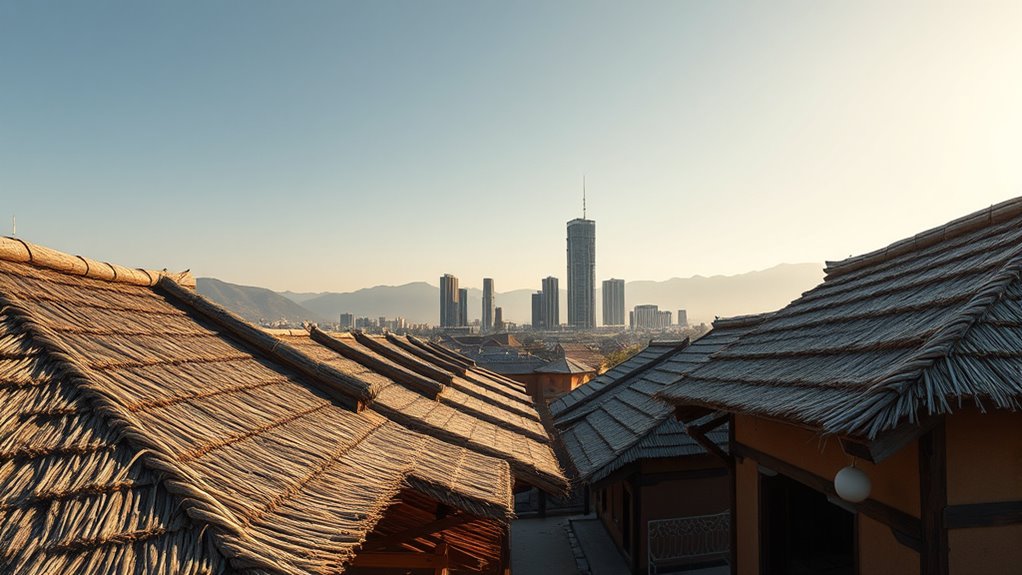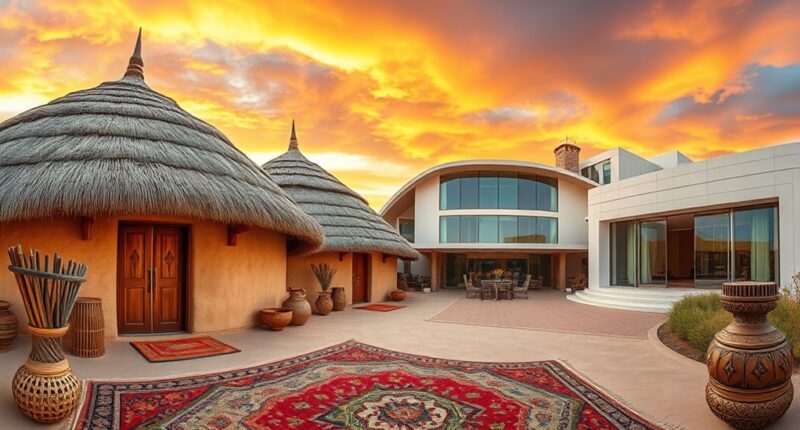Traditional housing, from Indigenous Gunyas to Japanese Minka, reflects your community’s culture, environment, and history. These structures showcase unique craftsmanship, use local, sustainable materials, and incorporate eco-friendly design practices like natural ventilation and passive cooling. They promote harmony with nature while offering durable, cost-effective solutions rooted in centuries of experience. Exploring these styles reveals valuable lessons in balancing aesthetics, functionality, and sustainability—discover how these ancient methods influence modern architecture and your community’s identity.
Key Takeaways
- Traditional housing styles like Gunyas reflect cultural identity, craftsmanship, and environmental adaptation across communities.
- They utilize locally sourced, sustainable materials and passive design techniques to enhance durability and energy efficiency.
- Such structures embody community stories, values, and environmental harmony, serving as cultural symbols and heritage preservation.
- Modern architecture can draw lessons from traditional practices to promote eco-friendly, cost-effective, and resilient building methods.
- Preserving traditional housing helps maintain cultural identity while offering sustainable solutions for contemporary architectural challenges.

Have you ever wondered what makes traditional housing styles unique? It’s not just their aesthetic appeal but the deeper stories they tell about a community’s history, values, and environment. Traditional homes often embody sustainable building practices that have been refined over generations, using locally sourced materials and construction methods that suit the climate and landscape. These structures are built to last, reducing the need for frequent repairs or replacements, which minimizes environmental impact. By focusing on sustainable building, these homes serve as living proof that eco-friendly architecture isn’t a modern invention but a time-honored tradition rooted in practicality and respect for nature.
Traditional homes showcase sustainable practices and cultural stories rooted in local materials and climate-aware design.
At the heart of traditional housing is cultural preservation. These homes are more than mere shelters; they are symbols of identity, showcasing unique craftsmanship, architectural styles, and cultural practices passed down through generations. When you look at a Gunya in Australia, for instance, you’re seeing a design shaped by the environment and cultural customs of its creators. Similarly, the intricate woodwork, ornaments, or layout of a Japanese minka or a Navajo hogan reflects centuries of cultural significance. Preserving these structures is essential because they encapsulate the stories, beliefs, and skills of a community. When you appreciate traditional homes, you’re also supporting efforts to safeguard cultural heritage, ensuring that future generations can learn from and connect with their history. Additionally, many traditional houses utilize natural ventilation and passive cooling techniques that reduce dependence on modern energy systems.
Traditional housing styles often prioritize harmony with the environment, promoting energy efficiency through natural ventilation, insulation, and strategic placement. These homes are not only environmentally friendly but also cost-effective, reducing reliance on artificial heating or cooling systems. This approach aligns with the principles of sustainable building, which aim to reduce ecological footprints without sacrificing comfort. As modern architecture increasingly emphasizes sustainability, looking back at traditional methods offers valuable lessons on how to create efficient, eco-conscious homes today.
In many ways, these houses serve as practical blueprints for sustainable living, blending functionality with cultural expression. They remind us that architecture doesn’t have to be solely about aesthetics or innovation; it can also be about respecting the environment and honoring history. By understanding and appreciating traditional housing, you recognize its role in shaping resilient communities and fostering cultural identity. In a world that often leans toward rapid modernization, these structures stand as a testament to the enduring power of sustainable building practices and cultural preservation, illustrating how our ancestors’ ingenuity can inform a more sustainable and culturally rich future.
Frequently Asked Questions
What Are the Environmental Impacts of Traditional Versus Modern Housing?
You’ll notice traditional housing often uses locally sourced, sustainable materials, reducing environmental impact and promoting material sustainability. However, they may lack energy efficiency compared to modern homes, which incorporate advanced insulation and energy-saving designs. Modern architecture tends to prioritize energy efficiency, but sometimes relies on less sustainable materials. Overall, balancing material sustainability and energy efficiency can help you minimize environmental impacts, regardless of whether you choose traditional or modern housing.
How Do Cultural Beliefs Influence Traditional Housing Designs Globally?
You might think cultural beliefs don’t shape housing designs, but they deeply influence them through cultural symbolism and belief systems. For example, in Japan, Shinto practices inspire homes with natural elements, while in India, Hindu symbolism influences spatial layouts. These beliefs guide materials, structures, and orientation, reflecting identity and values. Recognizing this connection helps you appreciate how traditional housing designs serve more than just shelter—they embody cultural stories and spiritual principles.
What Are the Cost Differences Between Building Traditional and Modern Homes?
You’ll find that modern homes generally have a higher cost comparison due to advanced materials and technology, while traditional houses tend to be more affordable because they use local, readily available resources. In an affordability analysis, traditional designs often save you money on construction and maintenance. However, modern homes might cost more upfront but can offer long-term savings through energy efficiency and durability.
How Have Technological Advancements Changed Traditional Housing Construction Methods?
Imagine how progress has transformed building techniques—technology now shapes traditional housing like an artist’s brush strokes. You benefit from material innovations such as reinforced concrete and prefabricated components, which make construction faster and more durable. These advancements streamline building processes, reducing costs and time. You can now construct homes that blend traditional aesthetics with modern resilience, showing how technological progress continues to elevate housing standards worldwide.
Are Traditional Homes More Sustainable Than Modern Architectural Structures?
Traditional homes are often more sustainable than modern structures because they use natural, sustainable materials like bamboo, clay, and thatch. These materials usually require less energy to produce and maintain, making the homes more energy-efficient. Plus, traditional designs often incorporate passive cooling and heating techniques, reducing reliance on energy-consuming systems. So, if you value sustainability, traditional homes can offer significant advantages over many modern architectural structures.
Conclusion
So, you’ve seen how gunyas transformed into sleek modern buildings—proof that humans really love a good makeover. Who knew that centuries-old bamboo and thatched roofs could be replaced with glass and steel, all while convincing ourselves we’re progressing? Next time you marvel at a skyscraper, remember it’s just traditional housing dressed up for the 21st century—still, somehow, missing that cozy charm of a simple gunya. Progress, after all, is just style over substance.









